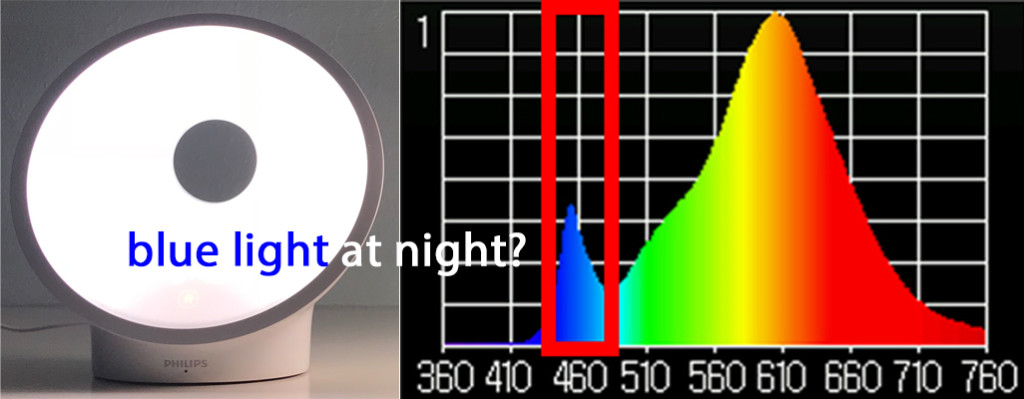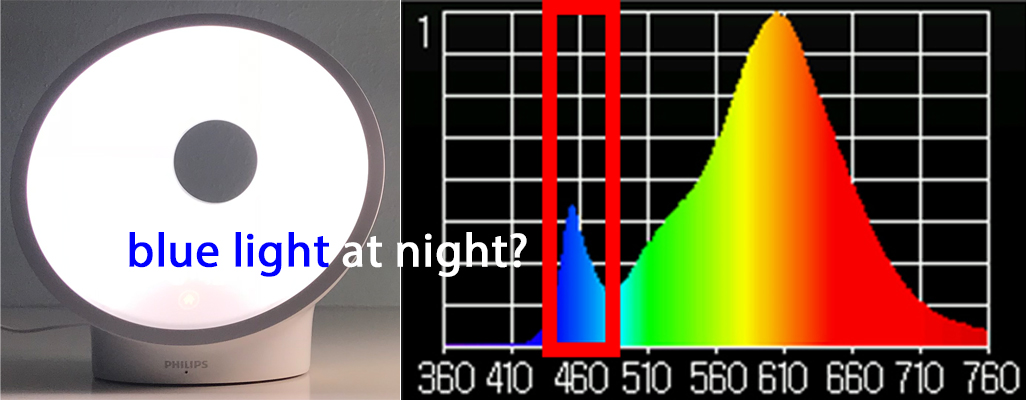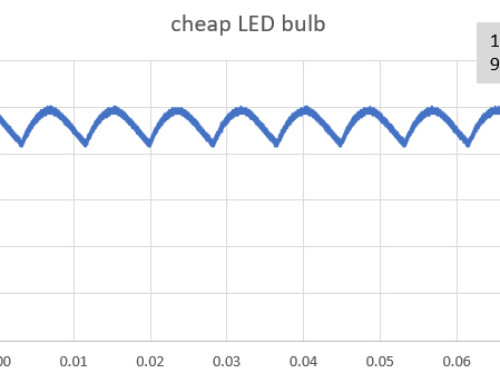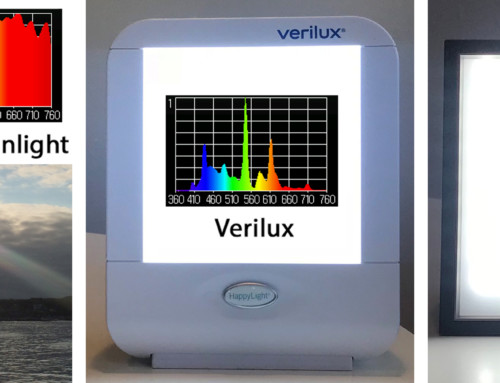The Philips Somneo lamp is the coolest alarm clock we’ve tested, allowing you to wake up with a simulated sunrise (sound is optional). While the alarm clock function works well, we were surprised to discover that the Somneo does not provide the natural lighting queues our bodies crave. As our measurements show, the light from the Somneo lamp is NOT good to use before going to sleep, or healthy to use at night. The Philips Somneo emits a LOT of blue light at night which interferes with your sleep (check out our measurements below)! Furthermore, while the light from the Somneo is OK at sunrise, the spectrum is not good for day-time use since it does not offer a stimulating daylight mode. Here we review the health claims around the Philip Somneo, which are principally focused on the light which comes from the Somneo. We leave the discussion of the user interface (not easy but acceptably intuitive), audio controls (wake up to the birds), and advanced functions (meditation aid?) to others. From a lighting perspective, the Somneo works well as an alarm clock, the Somneo’s morning light is appropriate (albeit a bit unnatural with too much blue) and waking up to a simulated sunrise is a great idea! Surprisingly, the Somneo does not deliver the evening light we need to prepare for sleep, nor enough light to read by safely at night, or the daylight we need to feel our best during the day.

light from the Philips Somneo contains a lot of blue which interferes with sleep (more on blue light and sleep here)
Natural light changes color and intensity with the time of day – queues which our bodies rely on for optimum sleep, mood, energy, metabolism and other functions (light synchronizes our circadian rhythms – more on this here). ‘Human Centric Lighting’ mixes together light from different colored LEDs to recreate the cycles of natural light. Philips deserves a lot of credit for pushing lighting technology, first with the Hue and now the Somneo lamp. Philips has done more than any other company to advance the color-mixing technology which allows lights to change color (for fun or to simulate natural light). The Somneo does a basic version of this, mixing together light from ‘warm-white’ LEDs (2700K) with red LEDs to change the light emitted by the Somneo. When you turn the Somneo fully on, the light from the lamp is reasonably bright and dominated by light from the 2700K warm-white LEDs – unfortunately those warm-white LEDs also emit a LOT of blue light (which studies show interferes with sleep – read more here). When in ‘night-light’ mode the light from the Somneo is red (no blue), but so dim that you can’t read (or see very well). The Somneo ‘night light mode’ only provides enough light to find your way to the bathroom. If you turn the intensity of the Somneo up, you start getting blue light! For those of us who need enough light at night to read or see well, the Somneo provides a lot of blue light at night!

light spectrum from a Philips Somneo as a function of intensity – the Somneo provides a lot of blue light at night except when in night-light mode which is too dim to read or work by.
The gold standard for healthy light is natural light: cycling from bright energizing sunlight during the day, to warm sunset and then biological darkness at night (read more here). The light from a Philips Somneo does change, but is optimized for sunrise (when extra blue is OK). As the infographic below shows, while the Somneo is OK to wake up with, surprisingly the Somneo does not provide healthy light in the evenings, at night, or during the day.

Philips Somneo compared to natural light illustrates how the Somneo is optimized for sunrise (when extra blue is OK or even desirable) but is NOT good to use at night (too much blue), or during the day (not stimulating)! While the Somneo is OK to wake up with, the Somneo does not provide healthy light in the evenings, at night, or during the day!






